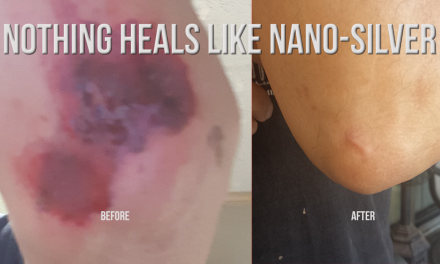Focus on Health
- Today’s clothing industry is a seven trillion dollar a year industry that uses an astounding 8,000 synthetic chemicals;
- Consumers have the mistaken illusion that synthetic fibers in clothing are safe;
- For over half a century people have been reacting negatively to chemicals interacting with their skin causing disorders like infertility, respiratory diseases, contact dermatitis and, yes, even cancer;
- The more synthetic clothing you wear, the greater your risk of absorbing toxic chemicals that can precipitate health conditions most often not attributed to synthetic fibers.
Key Points
- Your skin is the largest organ of elimination and absorption—what goes ON the skin goes IN the body;
- When toxins are absorbed through your skin, they are taken-up by the lymphatic system, then into the blood stream and eventually the liver—the chemical-processing plant of the body responsible for removing toxins;
- Your skin also keeps you healthy by actually venting approximately one pound of toxins daily;
- Petrochemical fibers restrict and suffocate your skin—shutting down toxic release rather than allowing it to escape—contributing to your total body burden and may be the trigger for the onset of disease;
- A “toxic soup” is created when combining multiple chemicals that interact to create an even more toxic substance and health consequences than individual chemicals by themselves.
Fabric may not be the first thing that comes to mind when you think about living a healthier lifestyle, but it definitely should be considered. Even many “health nuts” don’t realize that synthetic fabrics are teaming with chemicals and dyes that cannot be washed out, making them a potential health hazard.
Most synthetic fabrics, from towels to dress shirts and bed linens, are treated with chemicals during and after processing. These chemicals not only leach into the environment, impacting groundwater, wildlife, air and soil, but they also may be absorbed or inhaled directly.
“The use of man-made chemicals is increasing, and at the same time we have warning signals that a variety of wildlife and human health problems are becoming more prevalent,” says Dr. Richard Dixon, Head of the World Wildlife Federation (WWF) Scotland. “It is reckless to suggest there is no link between the two and give chemicals the benefit of the doubt. Urgent action is needed to replace hazardous chemicals with safer alternatives especially in clothing and other consumer products.”
WWF is so concerned about one fairly new clothing additive that they advised parents to check their children’s clothing labels. If the chemical is on it, they advise switching to clothing made from natural fibers whenever possible.

Teflon in Your Trousers
The chemicals that the WWF was warning about are perfluorinated chemicals (PFCs), which include the non-stick additive Teflon. These chemicals are increasingly being added to clothing because it makes them last longer and also can make them wrinkle-free. Most clothing labeled “no-iron” contains PFCs.
I have written about and consulted with patients worldwide regarding their allergic responses from synthetic fibers—bedding, clothing, car interiors, exercise/athletic clothing, mattresses, hats, etc.—that said, the frequency of recent incidents is very alarming to me and it should be to you. The allergic responses now commonly being reported as a result of these synthetic chemicals include, but are definitely not limited to:
- Skin rashes and lesions that can be cancerous
- Nausea
- Unexplained fatigue
- Burning and itching
- Unexplained headaches
- Blurred vision
- Difficulty breathing
- Reoccurring sinus infections not previously experienced
- Sudden inflammation and pain; especially in soft tissues
Keep in mind that if you have mysterious “invisible illnesses” that linger and yet you’re told “everything is within normal range,” it’s time to look into whether the fibers your clothes and bedding are made of could be the problem; it is for many.
Recent Case History:
The following is a quote from a patient of mine who I have worked with via long-distance for years. Hopefully her experience will assist others when mysterious skin eruptions appear and to further make my point about the toxicity of chemicals used in synthetic fibers and coloring.
“I wore a white cotton tank top with orange embroidery around the neck line. After a few hours the skin around the neck line was scratchy and bothersome so I removed the garment. I noticed small red irritation where the embroidery touched my skin but really thought very little of it as I assumed it would go away. After a few weeks the skin still appeared irritated so I started using my ‘safe’ moisturizing lotion. When this had no affect I saw a dermatologist and explained the situation. He determined the skin was pre-cancerous and prescribed a cortisone ointment for the next five weeks. If the skin is not completely healed at the end of this time the doctor said we need to remove it. I questioned the dermatologist about how and why this happened and he informed me that skin irritations such as these can lead to cancer.
I have been very careful to wear only 100 percent cotton for years and soak/wash any new clothes four times (powdered milk soak, safe detergent, vinegar, baking soda) prior to use since I have been immune challenged for years.
I have noticed that even if I touch my father’s colored cotton/polyester blend shirts/socks that I feel an odd sensation in my fingertips. This does not persist but is a very strange feeling. I have similar experiences with the cloth grocery bags from health food stores that make me immediately put it down. It is not the exact feeling of a static shock but close. The dermatologist shared with me that he has seen this type of reaction from other patients that can only be attributed to toxic chemicals and dyes used in manufacturing.”
Which Fabric Finishes “Scream” Toxic Chemicals?
- Easy Care—Wrinkle-free, shrinkage-free—these garments release formaldehyde;
- Water Repellent—Fluoropolymers (as in Teflon) are used to repel oil and water;
- Flame Retardants;
- Bacterial and Fungicidal Chemicals—Triclosan and nano-particles are used for these purposes, dangerous neurotoxins and irritants.
Fabrics containing Formaldehyde—linked to a 30 percent increase in lung cancer, skin/lung irritation and contact dermatitis:
- Anti-cling, anti-static, anti-shrink
- Waterproof
- Perspiration-proof
- Moth-proof and mildew resistant
- Chlorine resistant
It’s also used in dyes and printing to fix the design and prevent “running.” It is widely used in bedding so it’s best to use bedding that is all cotton and in light or white colors to eliminate risk from formaldehyde used to set colored fabrics.
What You Need to Know
- Most governments restrict formaldehyde levels in clothing… but NOT the U.S. One of the worst offenders is China. Beware of “Made in China” labels.
- Use of formaldehyde in clothing is extremely widespread. There have even been lawsuits alleging high levels of it in Victoria’s Secret bras.
- High temperatures and humidity make “poison clothes” even worse—they open your pores and increase chemical absorption.
- You absorb formaldehyde from multiple sources daily, so don’t be fooled by manufacturers’ reassurances.
- Disperse Blue Dyes may look gorgeous—even regal—but they put you at high risk for contact dermatitis. . . especially dark blue, brown, and black synthetic clothing. It’s important to note—laundering does not reverse that risk.
- Worse. . . Disperse Blue # 1 is classified as a human carcinogen due to high malignant tumor levels in lab animals.
- Incidentally, you might be interested to know that this dye also shows up in cosmetics and semi-permanent hair dyes.
Fire and Burn Hazards
The U.S. Marine Corps now prohibits troops in Iraq from wearing synthetic clothing while off base . . . after too many unfortunate burns from soldiers wearing polyester, acrylic, and nylon—which readily melts in high heat and fuses to the skin. (What did you expect? This stuff is a first cousin to plastic—both products of the oil industry.)
Of course, that begs the question of whether flame retardants are safer. . .
Historical Perspective
Flame Retardant use began in 1971, when government required children’s sleepwear to be self-extinguishing; their solution was to add Brominated Tris. Studies measuring urine samples showed that this chemical is readily absorbed.
Brominated Tris is a mutagen*, and causes cancer and sterility in animals and have also shown they cause testicular atrophy and sterility.
*Mutagens cause inheritable mutations by damaging DNA
Tris was banned in children’s clothing in 1977 (but lives on in upholstered furniture foam, baby carriers, and bassinets). Today most synthetic fabrics contain a new generation of flame retardants bonded into the fabric, which must survive 50+ washings.
According to the U.S. Consumer Product Safety Commission’s National Burn Center, only 36 children a year suffer serious injuries from sleepwear catching fire. My heart goes out to these tragic victims and their families. But is the toxic contamination of millions of children worth protecting 36 children per year from burns?
The Way I See It
This sort of regulation is a product of the “precautionary principle”—the notion that there should be no limit to the amount of money spent or the amount of inconvenience inflicted on millions of people when it comes to preventing rare dangers that affect a tiny number of people. The mania for making our society risk-proof and accident-proof actually increases danger in many cases.
The Consumer Product Safety Commission exempts certain sleepwear from flammability standards. Two companies selling kids’ sleepwear without flame retardants are L.L.Bean and Lands’ End.
But it’s not just children’s sleepwear—demand is high for fire-retardant uniforms and civilian clothing.
Lab studies show that flame retardants (PBDEs) can cause a slew of health issues—thyroid problems, brain damage, ADHD symptoms, fertility problems and even cancer.
The insecticide permethrin is now in civilian outdoor wear and military uniforms even though no long-term studies have assessed its safety.
Focus on Health
- Scientists find that restrictive bras suppress the lymphatic system—needed to flush toxins from your breasts and lymph nodes and to help prevent breast cancer;
- Despite wide appeal of synthetic athletic apparel, medical studies show that synthetic fibers cause muscle fatigue— which can make the difference between winning and losing for competitive athletes;
- A study of 24–27-year-old-males, showed that natural linen long sleeved shirts were worn for five hours—and then polyester ones were worn for another five hours. Their arms were monitored during both with electrodes measuring skin temperature and velocity of the men’s muscle tissue. No changes were measurable when they wore linen. However, when they donned polyester they endured a range of muscle disruptions.
Key Points
- While individual chemicals might not endanger your health, the synergistic effect of multiple chemicals (a “toxic soup”) interacting can have unpredictable negative health effects;
- Choose natural fibers. While not always as easy to find, its best to do so when possible:
Cotton — preferably organic still remains the “king” of textiles. Organic accounts for less than one percent of worldwide production;
Flax — one of nature’s strongest fibers;
Hemp — grows without any need for fungicides, herbicides, or pesticides because it’s naturally insect-resistant. Its fibers are reported to be four times stronger than cotton. This is NOT the hemp known for its mind-altering properties;
Silk — known as the “queen of fabrics.” Watch out for the use of synthetic dyes in this fiber.
Wool — most of today’s wool is contaminated with chemicals, i.e., pesticides used to kill parasites. But organic wool is becoming more common.
Other — alpaca, angora, camel, cashmere, mohair, ramie, aluyot.
You Need to Know…
The Organic Trade Association estimates that one non-organic cotton T-shirt uses one-third pound of pesticides and fertilizers. Cotton production uses one-fourth of the entire world’s fertilizers. It’s another good reason to choose organic cotton to add to the ones above.
Don’t get over-whelmed, start small. Choose organic for clothing closet to your skin most of the time—underwear, sleepwear, camisoles, sheets/pillow cases, etc. Build on your organic wardrobe as you replace items.
Are You Getting a Charge?
Electrostatic charges accumulate in synthetic clothing. There are reported incidents of shocking mini-explosions from mixing layers of synthetic clothing with synthetic carpeting. And get this…synthetic undergarments contribute to infertility in men.
A 24-month study of male dogs wearing either loose-fitting polyester underpants or loose-fitting cotton ones showed that wearing polyester created significant decreases in sperm count and degeneration of the testes. The animals wearing cotton suffered no side effects. (And, please, no emails to the editor about dogs wearing underwear. I agree, it sounds silly but no humans would volunteer!)
Scientists hypothesize that polyester traps body heat, encourages chemical absorption, and creates electrostatic buildup… which all affect sperm count.
Personal Perspective
I’m mindful of the problems with synthetic fibers and dyes because (cancer concerns aside) I’m sensitive to a wide range of chemicals as are most of my patients.
A few years ago I bought a beautiful set of sheets from an upscale store. The label said they were 100 percent cotton, but after sleeping in them a few nights I experienced all my old fibromyalgia pains that had long ago resolved (unless I eat foods in the nightshade genre or consume MSG) and I was now again experiencing bone and muscle pain from head to toe. Repeated washings didn’t get out whatever the offending substance was—it never does.
I got a terrible reaction from the dyes or maybe the chemicals used to make those all-cotton sheets ”no-iron.” You can only imagine what true synthetic cloth can do to us; after all, it’s largely a product of the oil industry. After I switched to a high-quality set of organic sheets, all my symptoms were resolved.
Invisible Saboteurs
We have the illusion that clothes made from synthetic fibers are safe, but the materials are in fact full of invisible chemicals the clothing industry prefers we donft think about.
A hundred years ago, clothing was made of natural fibers like cotton, flax, wool, and silk—synthetics weren’t developed until the early 1900s.
Although rayon was introduced in 1924, the first truly synthetic fiber was nylon, made by DuPont from the petroleum-molecule toluene. Nylon was first used because it was a popular material for women’s stockings and later panty hose.
Other synthetics followed:
- Acrylic (1950), aka, ”wash-and-wear fabrics”—a ”revolutionary time-saving leap” for homemakers.
- Polyester (1953), ”wrinkle free” fabrics developed from xylene and ethylene.
- Spandex and olefin (1959), which became the mainstay of sportswear, swim suits, and thermal underwear. Olefin is produced by ”cracking” petroleum molecules into propylene and ethylene gases.
The Way I See It
Don’t wait until you or a loved one has a health issue before changing the products you purchase. Yes, organic cotton does cost a bit more, but then isn’t it more cost effective to stay healthy than to get well?
I’m especially concerned about pregnant woman and their newborn children, make the decision as parents and grandparents to create a safe nontoxic nursery beginning with non-toxic no VOC paint to hard surface flooring, the crib and bedding and the clothing used for a newborn whose immune system is not fully developed to provide maximum protection, naturally.
Resources:
- www.cancerdefeated.com Clement, Anna Maria, and Clement, Brian, Killer Clothes: How Seemingly Innocent Clothing Choices Endanger Your Health . . . And How to Protect Yourself! Hippocrates Publications, 2011. p. 75.
- http://www.cool-organic-clothing.com/organic-clothes.html Much of the information in this article was taken from the book Killer Clothes, by the Clements.











